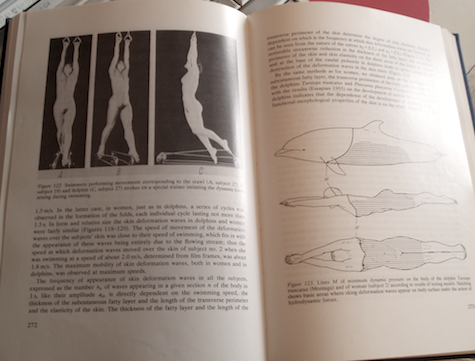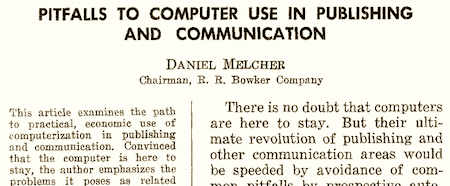Marc Abrahams's Blog, page 556
August 6, 2012
Computer Usefulness, 1969 and Now
In 1969 a publishing executive wryly tallied up whether and how computers had helped his industry:
“Pitfalls to Computer Use in Publishing and Communication,” Daniel Melcher, Journal of Business Communication, vol. 6, no. 2, Winter 1969, pp. 47-51. The author, chairman of the R.R. Bowker Company, says:
Most large publishers now have computers; many small ones use computers. Yet very few report net savings resulting from conversion to computer, and most went through agonies in the conversion process. All hope for tangible economies in the future. But the $5 million companies seem to expect economies when they reach $10 million — and the $10 million companies when they reach $20 million, and so on. [continued below the image]
Also, the economies of typesetting have benefited but modestly from computerization so far. Recently, for example, some systems analysts wrote that they had found a way to cut the cost of typesetting by 80 percent. Upon reading the small type it was revealed that the promised composition savings depended on getting the author to do the work of the compositor — and on getting him not to make corrections on proof. Any publisher who can achieve those things can make spectacular savings, with or without a computer.

Histogenesis of the Vagina of the One-Humped Camel
There’s progress at last in elucidating the histogenesis of the vagina of the one-humped camel (Camelus dromedarius). Details are in the study:
“Histogenesis of the Vagina of the One-Humped Camel (Camelus dromedarius): Morphological Evidence of the Histochemical Aspects,” Sameh Mohamed Farouk, Abdel-Hamid Kamel Osman [pictured here, lecturing in Japan] and Hussein Eidaroos, Cell and Developmental Biology, vol. 1, no. 3, 2012.
The authors, at Suez Canal University, Ismailia, Egypt, report:
“At the end of developmental stages, the lamina epithelialis became stratified squamous non-keratinized epithelium with slightly wavy basement membrane. The vaginal masculosa was differentiated into three layers; inner and outer longitudinal layers and middle circular one of smooth muscle bundles. With increasing age, a gradual increase of acid phosphatase, ATPase and Succenic dehydrogenase (SDH) reaction was observed especially in the epithelial lining and muscular coat of the vagina. A progressive increase of sudanophilic reaction and alkaline phosphatase activity was noticed among the different layers of the vaginal wall through the studied stages.”
(Thanks to investigator Marty Chalfie for bringing this to our attention.)

August 5, 2012
Tautogram paper record?
 Improbable suggests that attorney Dwight H. Merriam FAICP may have set a record back in July 2003. The record for the longest tautogrammatic title of any published scholarly paper. His title, which takes the from of an uninterrupted tautogram of no less than 10 words, was published in the journal Land Use Law & Zoning Digest, Volume 55, Issue 7, 2003, Special Issue: Cases 320-370.
Improbable suggests that attorney Dwight H. Merriam FAICP may have set a record back in July 2003. The record for the longest tautogrammatic title of any published scholarly paper. His title, which takes the from of an uninterrupted tautogram of no less than 10 words, was published in the journal Land Use Law & Zoning Digest, Volume 55, Issue 7, 2003, Special Issue: Cases 320-370.
‘Buckeye Bungled: Blatant Bifurcation Busts Broader Benefits, Begets Bigger Brouhaha’
Are we wrong? If so, send bigger examples to : 

August 4, 2012
Huh? Finger-length Ratios & Military Branches & Celebrity Worship
Which person goes into which branch of the military? The answer is related to the relative lengths of each person’s fingers, suggests this study by a researcher named Huh:
“Born to be a Marine: Digit ratios and military service,” HaengRyang Huh, Personality and Individual Differences, Volume 53, Issue 3, August 2012, Pages 166–168. The author, at Sejong University, Seoul, South Korea, explains:
“The current study tested the hypothesis that 2D:4D [the ratio of lengths of a person's second and fourth finger] would be associated with the type of military service chosen by young Korean males… Our research found evidence of small but significant group differences in 2D:4D among members of different branches of military service.
Huh also wrote the instant-classic study:
“Digit ratio and celebrity worship,” HaengRyang Huh, Personality and Individual Differences, Volume 52, Issue 3, February 2012, Pages 265–268. The author explains:
“Our research found evidence of a significant positive correlation between 2D:4D ratios and celebrity worship in females but not in males, which indicated that females with lower digit ratios were less likely to worship celebrities.
(Thanks to investigator Harry Ebb for bringing this to our attention.)

Russian research on naked swimmers & wild dolphins
Olympic swimmers owe some of their success to research done by a Russian scientist. Here’s a look back at our look back at his work:
Yuri Glebovich Aleyev used an electric winch to tow naked women under water at speeds of two to four metres per second. Later, his colleagues, when they peered at Aleyev’s films and photos, had reason to be upset. What they saw was not what anyone, except maybe Aleyev, was expecting.
Aleyev, who died in 1991, was one of the world’s great experts on nekton. Nekton is an obscure word for animals that swim where they wish, rather than merely drifting along. Plankton are not nekton. Fish, dolphins and people are. Aleyev spent much of his life and ingenuity trying to tease out the secrets of how good swimming creatures swim so well. The naked women served as stand-ins, so to speak, for wild dolphins.
Aleyev wanted to test something many of his colleagues believed…
And here are some images from his book called Nekton:


(And yet again, special thanks to biologist Frank Fish for being the first to tell us about Aliyev and his body of work with and one bodies.)

Gorilla Ig winners write about literary scamming Ig winners
Daniel Simons and Christopher Chabris, themselves Ig Nobel prize winners, write about recent research explaining why the Internet entrepreneurs of Nigeria, who collectively were awarded an Ig Nobel Prize, do what they do the way they do. The Simons/Chabris essay appears in the Wall Street Journal. It says, in part:
Why We Should Scam the Scammers
So why do the scammers persist in blanketing the world with outlandish propositions, announcing that they are from the very country whose name has become synonymous with online fraud? Cormac Herley [pictured here], a computer scientist at Microsoft Research who specializes in security issues, provides a convincing answer in a paper presented at a conference in Berlin and recently published on his website. In it, he analyzes the con mathematically, using an approach called signal detection theory. His crucial insight is to look at the situation not from the victim’s point of view but from that of the scammers. Their challenge is to hook only people who will get sucked in deeply enough to send a significant amount of money—the “true positives.” They must minimize the effort they devote to “false positives” (targets who might seem like dupes but are suspicious and/or never pay up)….
Simons and Chabris were awarded the 2004 Ig Nobel Prize in psychology for demonstrating that when people pay close attention to something, it’s all too easy to overlook anything else — even a woman in a gorilla suit.
The Internet entrepreneurs of Nigeria were awarded the 2005 Ig Nobel Prize in literature, for creating and then using e-mail to distributea bold series of short stories, thus introducing millions of readers to a cast of rich characters — General Sani Abacha, Mrs. Mariam Sanni Abacha, Barrister Jon A Mbeki Esq., and others — each of whom requires just a small amount of expense money so as to obtain access to the great wealth to which they are entitled and which they would like to share with the kind person who assists them.
BONUS: Our previous post about Herley’s study

Mucking Around in Class
 Martino [pictured here] mucks around, in this study:
Martino [pictured here] mucks around, in this study:
“Mucking Around in Class, Giving Crap, and Acting Cool: Adolescent Boys Enacting Masculinities at School,” Wayne Martino, Canadian Journal of Education / Revue canadienne de l’éducation, Vol. 25, No. 2 (2000), pp. 102-112. The author, at the University of Western Ontario, Canada, explains:
“I use a Foucauldian approach to examine how different versions of masculinity affect boys at one school, focusing specifically on mucking around in class and how boys learn to relate in peer group cultures.”

August 3, 2012
A necktie-tying machine
The sewing machine (of which, in truth, there were and are many) had a huge economic impact. Seth Goldstein’s necktie-tying machine, arriving many decades later, may have a smaller effect (thanks to investigator Jennie Regules for bringing this to our attention):

Ratto and Bravo on camelids
Today we look back at some too-slightly-celebrated work by Ratto and by Bravo.
 Ratto on centrifuged artificial llama vagina:
Ratto on centrifuged artificial llama vagina:
“Biochemical isolation and purification of ovulation-inducing factor (OIF) in seminal plasma of llamas,” Marcelo H Ratto [pictured here], Louis TJ Delbaere, Yvonne A Leduc, Roger A Pierson and Gregg P Adams, Reproductive Biology and Endocrinology, 2011; 9: 24. (Thanks to investigator Katherine Meusey for bringing this to our attention.) The authors report:
“Semen collected from male llamas by artificial vagina was centrifuged and the seminal plasma was harvested and stored frozen….
Bravo on responses to copulation in South American camelids:
Bravo PW, Stabenfeldt GH, Lasley BL, Fowler ME. “The effect of ovarian follicular size on pituitary and ovarian responses to copulation in domesticated South American camelids,” Biology of Reproduction, 1991;45:553–559.

Video teaser for the new book “This Is Improbable”
This little video teaser gives the flavor, and even a brassiere, from my new book, This Is Improbable. The book will be published on September 6, in the UK and the US. The publisher’s web site has extra info.
BONUS: Someone, somewhere may be wondering “What is the new book’s ISBN?” For that person, wherever she or he may be, here’s the answer: 9781851689316.


Marc Abrahams's Blog
- Marc Abrahams's profile
- 14 followers
























